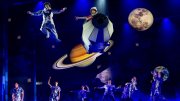Miscellaneous mentions:
In a glowing review of Gustavo Dudamel's debut as music director of the Los Angeles Philharmonic, New York Times music critic Anthony Tommasini cites a new work by composer John Adams '69, A.M. '72, as a brilliant, "searching, experimental de facto symphony." Highlights of Tommasini's appraisal:
Making a telling artistic statement, Mr. Dudamel began his tenure conducting the premiere of the new Adams piece, “City Noir,” a bustling, complex 35-minute work in three movements: the final panel in a triptych of orchestral works inspired by what Mr. Adams calls the “California experience,” its “landscape and its culture.” (The first two are “El Dorado” and “The Dharma at Big Sur,” a violin concerto.)
The piece was suggested, Mr. Adams has written, by the richly evocative books on California’s social history by Kevin Starr [Ph.D. ’69], especially a chapter called “Black Dahlia,” which explores the sassy, shoddy and sensational era of the 1940s and ’50s, which gave rise to film noir. It is not easy to evoke the milieu of an era in music. But this score was also inspired by jazz-inflected American symphonic music of the 1920s through the ’50s, from Gershwin to Copland to Bernstein, something that is a lot easier to evoke.
Mr. Adams does so brilliantly in this searching, experimental de facto symphony. The first movement, “The City and Its Double,” begins with a wash of orchestral sound, murmuring motifs and rhythmic shards. Scurrying figurations break out and whirl around, getting stuck in place one moment, spiraling off frenetically the next. Is this harmonically astringent be-bop or weird echoes of a Baroque toccata?
Eventually the violins begin a winding, sometimes aimless-sounding episode of fitful, churning lines. Mr. Adams has become a master at piling up materials in thick yet lucid layers. Moment to moment the music is riveting. Yet, as in some other Adams scores, I found it hard to discern the structural spans and architecture of this one. The pensive second movement, “The Song Is for You,” with its hazy sonorities, slithering chords, sultry jazzy solos and undulant riffs, does somehow convey California. The third movement, “Boulevard Night,” begins languorously but soon erupts, all jagged, quirky and relentless. Call it “The Rite of Swing.”
For background on the roots of Adams's music, read this review of his memoir, Hallelujah Junction., from the pages of Harvard Magazine.
Times education reporter Sara Rimer visited Greencastle, Indiana, where Brian W. Casey, Ph.D. '00, former associate academic dean in the Faculty of Arts and Sciences, is now president of DePauw University. Her article, from the "Home" section, details Casey's efforts to open up the campus and change its culture and conversations by redecorating an enormous official residence, The Elms, to make it much more welcoming to the whole community. Casey has moved up considerably: he formerly lived in a converted industrial loft in Pawtucket, Rhode Island. A fuller account by Rimer can be found at "The Choice," a Times blog, here.
And New Yorker Washington, D.C., correspondent Ryan Lizza, writing in the October 12 issue (the magazine's "Money Issue"), offers "Inside the Crisis"--a detailed examination of President Barack Obama's economic team, and particularly Lawrence H. Summers, director of the National Economic Council. The extended profile covers not only the recent financial crises and the government response, but the range of Summers's intellectual interests from boyhood through his education, his service in Washington, and his tumultuous Harvard presidency, and the evolution of his policy prescriptions in light of current economic conditions.








